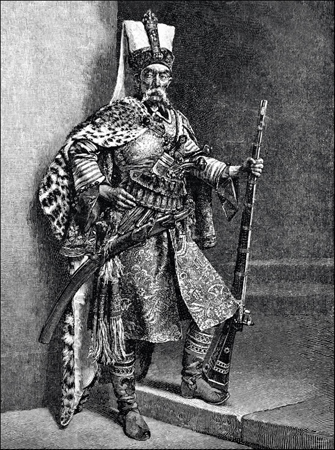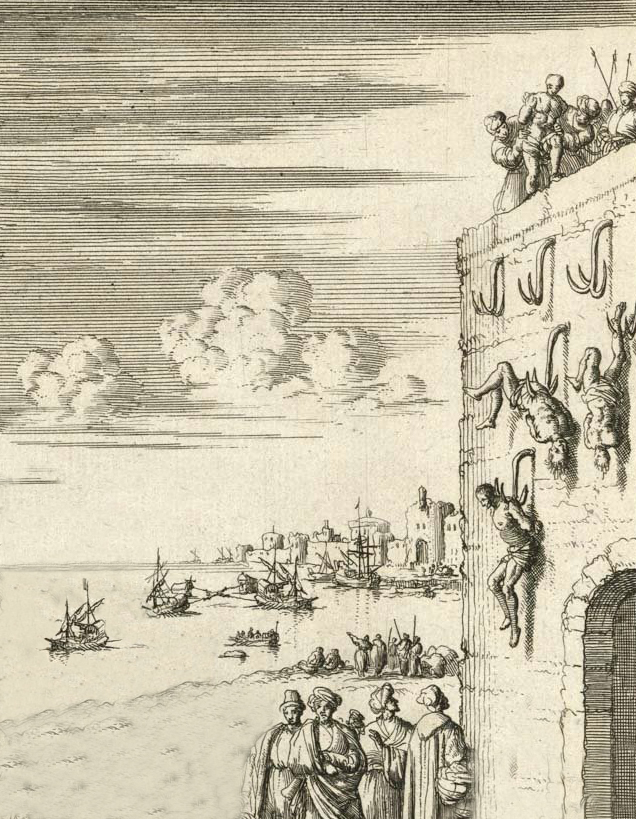(This post is a continuation of Janissaries in Algiers – Parts 1 – 6. If you haven’t done so already, it’s best to read those posts before continuing on here.)
As we saw in the last post here in this blog, after the banishments of the Kouloughlis (the sons of janissaries and Algerine women) and the confiscation of their lands and goods, the stage was set for a major confrontation between them and the rulers of Algiers—the majority of whom were janissaries.
A band of determined Kouloughlis crept back into the city. Their plan was to take over the Kasbah—the fortress at the top of the city—and use the resources it contained (huge amounts of gunpowder and shot) to launch their rebellion.
Here is a contemporary European description of how the things played out.
In the year 1632, in midsummer, fifteen Kouloughlis disguised in women’s clothing approached the Kasbah. The gate guard of the fortress blocked these fifteen counterfeit women from entering, but they demanded the key to the fortress from him. He dared not deny them. Some of them then walked up along the wall and took off their disguises. The gate guard saw this and realized that they were Kouloughlis who had been expelled from the city
The story circulated throughout the town that the fortress of the Kasbah was occupied and that something secretive was going on. Initially, people thought some Christian slaves had entered the fortress and had taken it over. This rumor circulated quickly, and everyone locked their doors in panic.
Then the truth got out that the Kouloughlis had taken the Kasbah. The members of the Divan [the ruling council of Algiers] received this news. The leaders conferred together and then went to the Kasbah.
The Kouloughlis said to them, “Now we have power over you Turks, you thieves who stole our property and our women and children. Now we will possess this place!”
The members of the Council replied, with great humility, “We will reward you if you promise us that you will return the fortress to us unspoiled. Everything will be returned to you, and you shall live as our welcome neighbors.”
But the Kouloughlis answered, “We know your lies and cunning ways too well. We will not heed your tempting words, and we will not surrender. Instead, now that we are here, we will commit an act that will long be remembered.”
They then went down to the powder magazine in the cellar of the fortress and tried to haul up some of the powder kegs, but they could only fetch one, and only with great difficulty. Two others they could not shift at all. After that, they set alight the gunpowder in the magazine and blew up the fortress, creating a crater that was thirty fathoms or more across. Seventy houses were destroyed inside the confines of the fortress. Outside, well over a hundred were wrecked.
The fortress went up in a massive explosion that was astonishing to hear, throwing large stones far into the air which smashed houses when they hit the ground, for some were so large it took three men to cart them away. These stones also fell on croplands and pastures. Over a thousand people were killed. The explosion tore bodies into bits, and heads and arms and other body parts came raining down.
Out of the fifteen Kollórar, four survived. They were bound and tortured. Many small holes were cut into their bodies and fire was inserted into the incisions. The Kouloughlis were then taken out of the city. Their final torment was to be thrown over the wall onto iron hooks. They hung there, impaled, until they died. One of them lived on for three days, until a Turk shot him.
The fortress was then rebuilt.
Here is another European description of the obliteration of the Kasbah:
The Kouloughli defendants, feeling desperate, and unable to make any further resistance, ignited twenty thousand quintals of powder, blew a piece of ordnance out of the fortress to the fish gate, a mile away, spoiled many houses, and would have destroyed the whole city, except that the Kasbah is situated atop a stupendous mountain, with the city lying below it, and the nature of explosive powder is to rise upwards.
The sky was darkened with smoke and dust, and nothing heard but clamors in the streets, as if the Day of Judgement had arrived.
A quintal was the equivalent of 100 pounds (45 kilos). So according to this estimate, the embattled Kouloughlis detonated something like 2,000,000 pounds (900,000 kilos) of gunpowder.
This seems an unrealistically huge amount of gunpowder, and it is likely an exaggeration. But, given the massive scale of the explosion, however many actual pounds/kilos of gunpowder the Kouloughlis set alight, it was a lot.
Here is one final European assessment of the failed Kouloughli rebellion:
A dozen years ago, the Kouloughlis launched a rebellion and, in an attempt to take control of the city and the state, captured the Kasbah. They were besieged by both Turks and renegades, many of them fathers of the rebels.
The Kouloughlis’ resistance was so stubborn that they blew up the Kasbah. Those who survived lost their heads. In my own time, some of these severed heads still decorated the walls around the Bab al-Oued gate—a pitiful relic of paternal revenge, for most of the besieged and the besiegers were fathers and sons, uncles and nephews, or at least first cousins.
Since that time, the Kouloughlis have had no voice in the government of Algiers, do not receive any public pay, and are permitted to join corsair expeditions only on the condition that they receive no wages or salaries but just a simple share in the common profits.
It was a century or more before the Kouloughlis were able to resume their former place in Algerine society.
Moral of the story?
Don’t mess with Algerine janissaries.
For those who may be interested…
The first description of the occupation and destruction of the Kasbah comes from Chapter XXXIV of Björn Jónsson’s, Tyrkjaráns-Saga, (The Turkish Raid Saga), a book written (in Icelandic) in 1643.
The second description of the Kasbah’s obliteration (the one containing the estimate of the amount of gunpowder that exploded) comes from Francis Knight’s A Relation of Seven Yeares Slaverie Under the Turkes of Argeire, suffered by an English Captive Merchant, published in 1640, p. 3.
The final European assessment of the failed Kouloughli rebellion comes from René du Chastelet des Boys’ l’Odyssée, ou diversité d’aventures, rencontres et voyages en Europe Asie et Afrique (The Odyssey, or Diverse Adventures, Encounters, and Voyages in Europe, Asia, and Africa), published in 1665, pp. 63-64.
Finally…
The form of execution the Kouloughlis suffered when they were “thrown over the wall onto iron hooks “ was known as ganching (the term derives from the Spanish/Portuguese word for hook: “gancho”). Here is a description:
“They have large hooks of serpent-tongued iron, which they call ganches in Lingua Franca, and which are set into the walls. Upon these, they hang those whom they wish to put to death. First, they strip the victims naked and bind their hands behind their backs. Then they push them off the top of the wall so that they fall and are entangled upon the hooks, sometimes caught in the belly, sometimes in the shoulder or by some other part of the body. Thus they die slowly” (Pierre Dan Histoire de Barbarie, p. 414).
Below, is a seventeenth century depiction of ganching.

Corsairs and Captives
Narratives from the Age of the Barbary Pirates
View Amazon listing
The Travels of Reverend Ólafur Egilsson
The story of the Barbary corsair raid on Iceland in 1627
View Amazon listing
